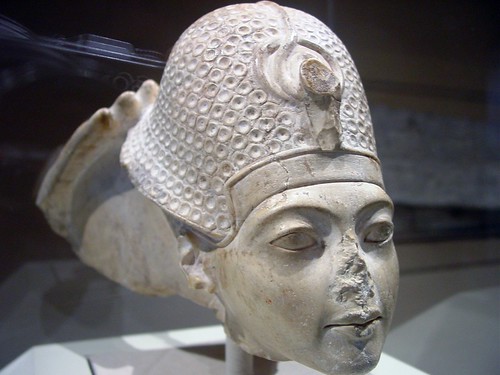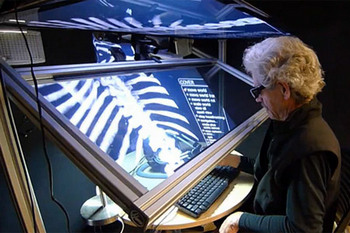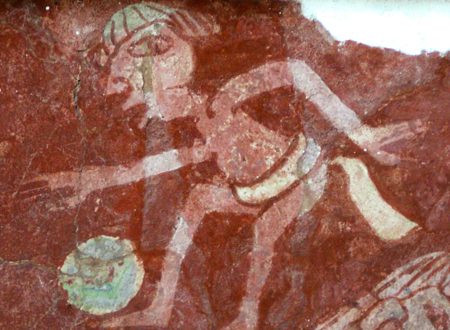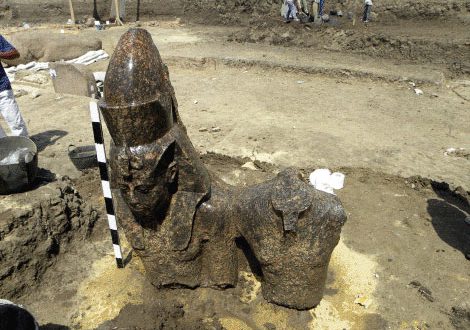 In 1908, more than a decade before the discovery of Tutankhamun’s tomb, American retired lawyer and archaeologist Theodore Davis made a remarkable discovery. While excavating in the Valley of the Kings in Egypt, he unearthed about a dozen large storage jars. Their contents included broken pottery, bags of natron, bags of sawdust, floral collars, and pieces of linen with markings from years 6 and 8 during the reign of a then little-known pharaoh named Tutankhamun. The significance of the find was not immediately understood, and the objects entered the collection of The Metropolitan Museum of Art as a mystery. It was only several years later, after further excavations and study, that the Museums Herbert E. Winlock was able to identify them: the small cache contained the remains from the embalming and funeral of King Tut. These objects now get their own exhibition – Tutankhamun’s Funeral – which runs at New York’s Met until November 6th.
In 1908, more than a decade before the discovery of Tutankhamun’s tomb, American retired lawyer and archaeologist Theodore Davis made a remarkable discovery. While excavating in the Valley of the Kings in Egypt, he unearthed about a dozen large storage jars. Their contents included broken pottery, bags of natron, bags of sawdust, floral collars, and pieces of linen with markings from years 6 and 8 during the reign of a then little-known pharaoh named Tutankhamun. The significance of the find was not immediately understood, and the objects entered the collection of The Metropolitan Museum of Art as a mystery. It was only several years later, after further excavations and study, that the Museums Herbert E. Winlock was able to identify them: the small cache contained the remains from the embalming and funeral of King Tut. These objects now get their own exhibition – Tutankhamun’s Funeral – which runs at New York’s Met until November 6th.
Often called ‘the Boy King’, Tutankhamun was about nine years old when he ascended the throne of ancient Egypt. He died approximately nine years later, possibly owing to causes that include a weakened immune system and malaria. His death may have been unexpected, so his own tomb was still unfinished. The rather small tomb in which he was actually buried – and which you can visit in King Tut Virtual – had been started for another person, not for a king. Eventually, workmen’s huts completely hid the entrance to the tomb, and its location was forgotten.
The discovery of the storage vessels by Theodore Davis and the accurate identification of their contents helped lead Howard Carter and Lord Carnarvon to the discovery of King Tut’s tomb (watch the video series).
The large, sealed storage jars containing carefully packed equipment and objects were found in KV54 – not so much a tomb, but rather a small pit near to the tomb of Seti I discovered in 1907. Theodore Davis who funded the excavations got permission to take six of the storage jars out of Egypt and in 1909 donated them to the Metropolitan Museum of Art in New York. He then in 1912 – published his findings in a book (The Tombs of Harmhabi and Touatankhamanou) and told the press he had discovered the tomb of Tutankhamun. In 1914 Davis’ concession to excavate in the Valley of the Kings was passed on to Lord Carnarvon.
Star Objects from Tutankhamun’s Embalming Cache
- Linen containing hieratic writing which reads “The good god, Lord of the Two Lands, Nebkheperure, beloved of Min. Linen of year 6.” (Nebkheperure is Tutankhamun’s Prenomen)
- The Florar collar found in KV54 that holds clues to when King Tut died.
In time, Herbert Winlock, curator and field director of the Metropolitan’s Egyptian excavations and in the 1930s Director of the Museum, came to realize that the natron (a mixture of sodium carbonate, sodium bicarbonate, sodium sulphate, and sodium chloride that occurs naturally in Egypt, as Salima Ikram tells us in this video) and linen were the embalming refuse from the mummification of Tutankhamun. He also suggested that the animal bones, pottery, and collars might have come from a funeral meal.
Winlock’s analysis KV54 was an embalming cache rather than King Tut’s tomb – was an important clue that led to Howard Carter’s 1922 discovery of KV62 some 110 metres away from where the storage jars were unearthed.
When did King Tut die?
The funeral materials unearthed by Theodore Davis (who discovered the tomb of Yuya and Thuya, Tut’s great-grandparents as well) might even bear clues to solve another riddle in the King Tut puzzle: when did Tutankhamun die? Scholars studying the funerary cache have been able to reconstruct details of his death and burial. We already knew that the Boy King died young – at age 19 – but now scientists might have nailed down the exact season of his death. Botanical analysis of the well-preserved, more than 3,000-year-old floral collars indicates that the plants they contain flower in Egypt between late February and midMarch. Since the complex process of mummification (here explained by DrZahi Hawass) took about 70 days, it is now believed that King Tut probably died in December or January.
Tutankhamun’s Funeral Exhibition at the Met
The exhibition, Tutankhamun’s Funeral, will feature jars, lids, bowls, floral collars, linen sheets, and bandages that were used at the pharaoh’s mummification and the rites associated with his burial and related objects. These include a sculpted head of Tutankhamun as a youth, and several facsimile paintings depicting funerary rituals. Archival photographs from the early 20th century by Harry Burton, the Museum’s expedition photographer, will provide an evocative background.
The exhibition Tutankhamun’s Funeral at the Metropolitan Museum of Art in New York City – which runs until November 6th – will explore the materials and rituals associated with the burial of the pharaoh. The presentation will include some 60 objects, primarily from the Met’s own collection. The objects on display at the Met complement a major exhibition of treasures from the tomb of Tutankhamun ‘King Tut NYC- Return of the King Tutankhamun and the Golden Age of the Pharoahs‘ on view April 23th 2010 to January 2th 2011, at the Discovery Times Square Exposition.





